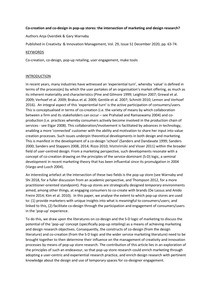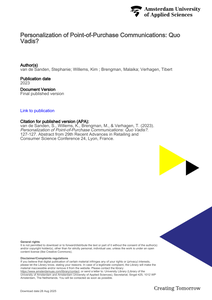Service robots provide retailers with new opportunities to innovate their in-store service offerings. Despite advances made in the fields of human-robot interaction, information systems, and marketing, there is relatively little known about how to apply a service robot in retailing. In this paper we aim to shed light on this issue by exploring the added value, roles, and prototyping of a service robot in fashion retailing. Using two Dutch fashion stores as real-life settings, we apply differentinteraction techniques (observation, interview, survey, structured role play, prototyping) to generate first insights and obtain lessons learned. The results of our study suggest that fashion retailers would benefit most from using service robots for communication of promotions and provision of product information. When applying service robots to these use cases, customers seem to prefer briefly and clearly expressed information that is communicated in a style that matches (in-)store communications. Still, the lack of personal attention and social support associated with a service robot makes retailers and store personnel rather reluctant to use them for their service excellence-oriented stores.
MULTIFILE

Co-creation as a concept and process has been prominent in both marketing and design research over the past ten years. Referring respectively to the active collaboration of firms with their stakeholders in value creation, or to the participation of design users in the design research process, there has arguably been little common discourse between these academic disciplines. This article seeks to redress this deficiency by connecting marketing and design research together—and particularly the concepts of co-creation and co-design—to advance theory and broaden the scope of applied research into the topic. It does this by elaborating the notion of the pop-up store as temporary place of consumer/user engagement, to build common ground for theory and experimentation in terms of allowing marketers insight into what is meaningful to consumers and in terms of facilitating co-design. The article describes two case studies, which outline how this can occur and concludes by proposing principles and an agenda for future marketing/design pop-up research. This is the peer reviewed version of the following article: Overdiek A. & Warnaby G. (2020), "Co-creation and co-design in pop-up stores: the intersection of marketing and design research?", Creativity & Innovation Management, Vol. 29, Issue S1, pp. 63-74, which has been published in final form at https://doi.org/10.1111/caim.12373. This article may be used for non-commercial purposes in accordance with Wiley Terms and Conditions for Use of Self-Archived Versions. LinkedIn: https://nl.linkedin.com/in/overdiek12345
MULTIFILE

Cross-border e-commerce is flourishing worldwide and is particularly intriguing because it allows sellers and buyers to regularly cross national borders to distant and distinct countries via the Internet. Marketers need to understand the challenges retailers and consumers may face to develop effective marketing strategies, attract foreign consumers to retailers’ websites, and convert their visits into actual purchases. This dissertation contributes to the growing literature on cross-border e-commerce by examining how e-retailers can shape their marketing strategy to reach foreign consumers who may make a purchase and what drives consumers’ perceptions and preferences before making thatpurchase. To this end, study 1 examines how and to what extent small e-retailers can shape their marketing strategies to increase their use of digital marketing tactics and thereby improve their performance in foreign markets by comparing e-retailers originating from developed and emerging e-commerce markets. Study 2 focuses on how store values and country stereotype perceptions leadto higher trust between consumers and retailers in foreign e-stores, and how this differs for European consumers shopping at U.S. and Chinese e-stores. The thirdstudy addresses why consumers buy from foreign e-stores when they can buy domestically. It examines three different categories of determinants across generational cohorts: e-store characteristics, domain-specific values, and human values. Overall, this dissertation demonstrates the drivers of small retailers’ business performance and consumers’ purchase intentions in cross-bordere-commerce while showing that neither e-retailers nor consumers should be considered uniform or generalizable.
DOCUMENT

This research aims to investigate the impacts of Covid -19 on Bethlehem and examine the potential recovery strategies for the tourism sector during and after the pandemic. This research contributes in fulfilling intriguing gaps in literature on the impacts of Covid-19 on Bethlehem. All data collected were in the period of August and September 2020. This study is exploratory in nature applying qualitative and quantitative methods. Open-ended questions used in the interviews and the interviews were analysed. In addition, open and closed-ended questions carried out with fifty-two respondents from tourism business owners and key player stakeholders in Bethlehem’s tourism sector. The findings show that the COVID-19 pandemic resulted in that all Bethlehem’s tourism sector and sub-sectors suffered from the COVID-19 pandemic, however, the worst affected sub-sectors are souvenir stores and accommodation, while the least affected industry in the tourist restaurants sub-sector. The pandemic has resulted in massive job losses in Bethlehem. Bethlehem’s tourism sector has implemented pay cuts and laying off workers as a way of mitigating loss of revenue resulting from the outbreak of the COVID-19 pandemic. Finally, this research provides academic as well as managerial implications.
LINK
In an era of information overload, relevance is key. Even more so in thephysical store, where consumers are in a ‘shopping state of mind’ (Shankaret al., 2010), and where still a significant proportion of all purchasedecisions is being made.Relevance can be achieved by filtering information and targeting shopperswith context-aware messages (Riegger at al. 2022). A commonly studiedexample is that of location-based messaging (i.e. aligning the message withthe consumers’ geographic position; Meents et al. 2020). An alternativeapproach is to adapt the message to the characteristics and behavior of thein-store receiver in question, implying personalization of communication.Various technological devices can be used by retailers to transferpersonalized messages to shoppers in their stores. The focus of this studyis on digital signage (DS) in stores, as these are commonly used byretailers for their digital in-store communication.While the personalization of DS messages may benefit customers (e.g.message relevance), it also comes with high perceived risk to individualprivacy (Hess et al. 2020) To employ these type of personalized messageseffectively, it is important to understand how customers feel and respond.The present study has four objectives, examining (1) whether theperceived benefits of varying levels of personalized DS communication atthe point-of-sale outweigh the perceived risks, (2) why or why not, and (3)who is more and less open to it, and (4) for which specific situations is itmore accepted. We address these objectives both from a practitioner andconsumer perspective, using a mixed-methods approach.First, we have conducted 16 exploratory expert interviews with variousspecialists in the domain of artificial intelligence, shopper marketing, datamanagement and consumer privacy. Transcripts have been contentanalyzedusing NVIVO 12 software. Insights emerged in terms of how toimplement personalized targeting via DS in retail stores, minding legal aswell as ethical challenges in preserving consumer privacy. For example,the level of personalization via in-store digital screens differs greatly; DScontent can be adapted based on customers’ demographics, emotions,preferences and shopping behavior, and all possible combinations of suchpersonal information. It is expected that customers will responddifferently, depending on the level of personalization.In Spring 2023, these results will be complemented based on a consumersurvey. That way, consumers and a multitude of specialists in the smartservices context of personalized communication at the point-of-sale havebeen investigated, allowing for setting the boundaries in terms ofdesirability and feasibility (technology- and privacy preservation-wise).
MULTIFILE

Although it appears increasingly important yet potentially challenging to attract consumers to physical stores, location‐based messaging has been said to enable such attraction. Still, existing studies offer very limited insight into which particular location‐based persuasion approach retailers should use. This study aimed to establish and compare the potential of two discrepant persuasion strategies to influence consumers’ experiences and thereby stimulate them to visit the retailer's physical store. Drawing on persuasion theory and construal level theory, and using a vignette‐based online survey method, we determined that scarcity is a more effective persuasion strategy in the studied context than social proof; scarcity‐focused messages are experienced as more informative, more entertaining and less irritating, are therefore valued more, and are thus more likely to induce store visits. We discuss these findings and their implications for theory as well as for practice.
DOCUMENT

PurposePhysical stores are increasingly dependent on impulse visits and the impulse purchases of passers-by. Interactive advertising screens in store windows could help retailers increase impulse-visit urges and impulse-buying urges. However, the effects of interactive screens in physical surroundings have not been studied before. Therefore, this study aimed to examine the effect of interactive screens on impulse urges and gain insight into the underlying mechanism that explains the possible effect.Design/methodology/approachAn interactive screen was placed in a store window. Using three field experiments, we studied the effect of interactivity-level (high vs low) on the impulse-visit and impulse-buying urges of passers-by, and the mediating role of self-agency in these effects.FindingsHighly interactive (compared to less interactive) advertising screens in store windows positively affect impulse-visit and impulse-buying urges through self-agency. Retailers can therefore use interactive advertising screens to increase the number of impulse purchases if feelings of self-agency are activated.Originality/valueThis is the first study to examine the extent to which interactive screens in a store window enhance the impulse-visit and impulse-buying urges of passers-by and the mediating factor of these effects. By conducting three field experiments, we achieved a high external validity and managed to share very reliable results owing to the replication of the findings.
DOCUMENT

Hundreds of sensors in our smartphones, cars, houses and other "smart" devices feed the IoT, that monitors both our functioning, and that of the smart devices. In 2050 the Internet of Things - which processes and stores all sensor data - will require a multiple of all the current energy together in air traffic and meat consumption. Living an environmentally friendly life will be just a drop in the ocean. With every step we take, servers all over the world start to analyze and store sensor data from the smartphone in our pocket. Habermas states that the system supplants ("colonizes") the lifeworld. It is of great importance that economic and social disciplines make a serious effort to restore the balance between the system world and the lifeworld.
MULTIFILE

Although it appears increasingly important yet potentially challenging to attract customers to physical stores, location-based messaging, i.e., delivering mobile phone messages using data about the recipient's location when that recipient is near the sender, has been said to enable such attraction. Still, existing studies offer very limited insight into which particular location-based persuasion approach retailers should use. Drawing on persuasion theory, this exploratory study aims to investigate and compare the potential of two discrepant persuasion techniques (scarcity and social proof) to influence customers' experiences and thereby stimulate them to visit the retailer's physical store. A factorial survey design was applied to test the research model. Data were collected from a sample of actual customers of a Dutch fashion retailer (n = 579). The results suggest that scarcity is a more effective persuasion technique in the studied context than social proof; scarcity-focused messages appear to be experienced as more informative, more entertaining and less irritating, seem to be valued more because of this, and are thus more likely to incline customers to visit the store. We discuss these findings and their implications for theory as well as for practice.
MULTIFILE
